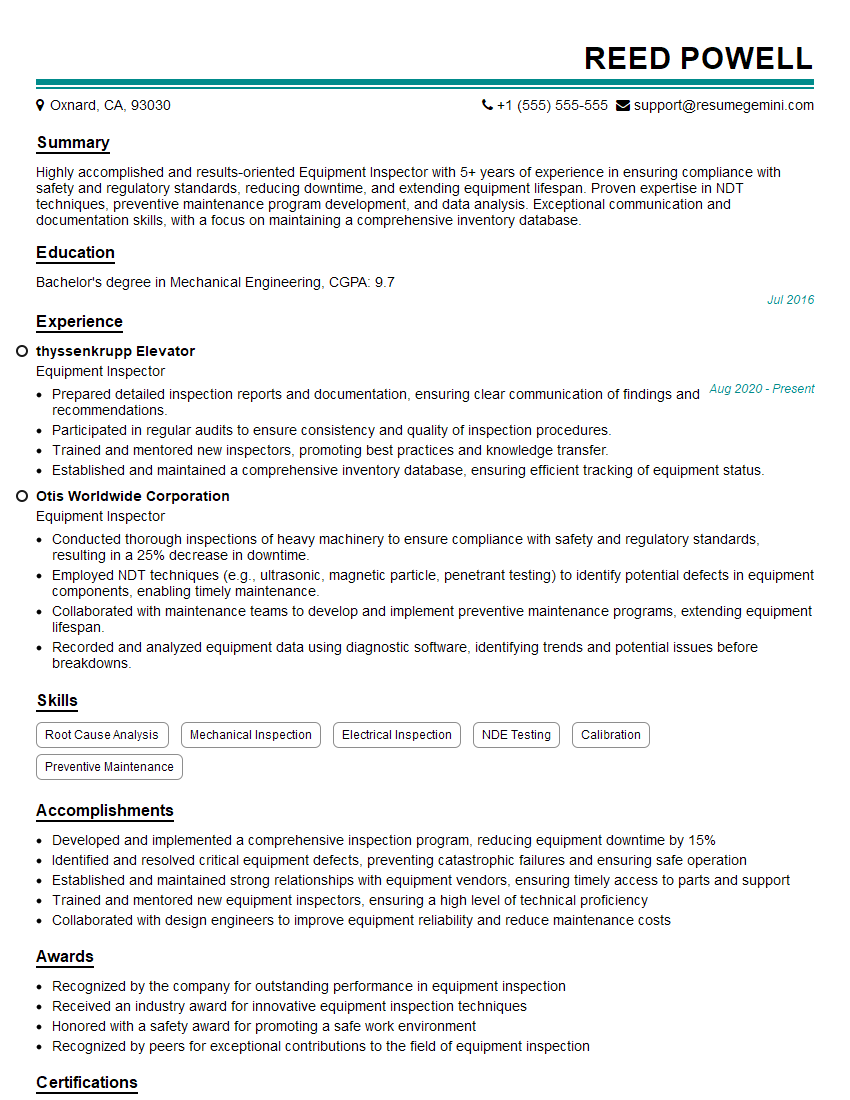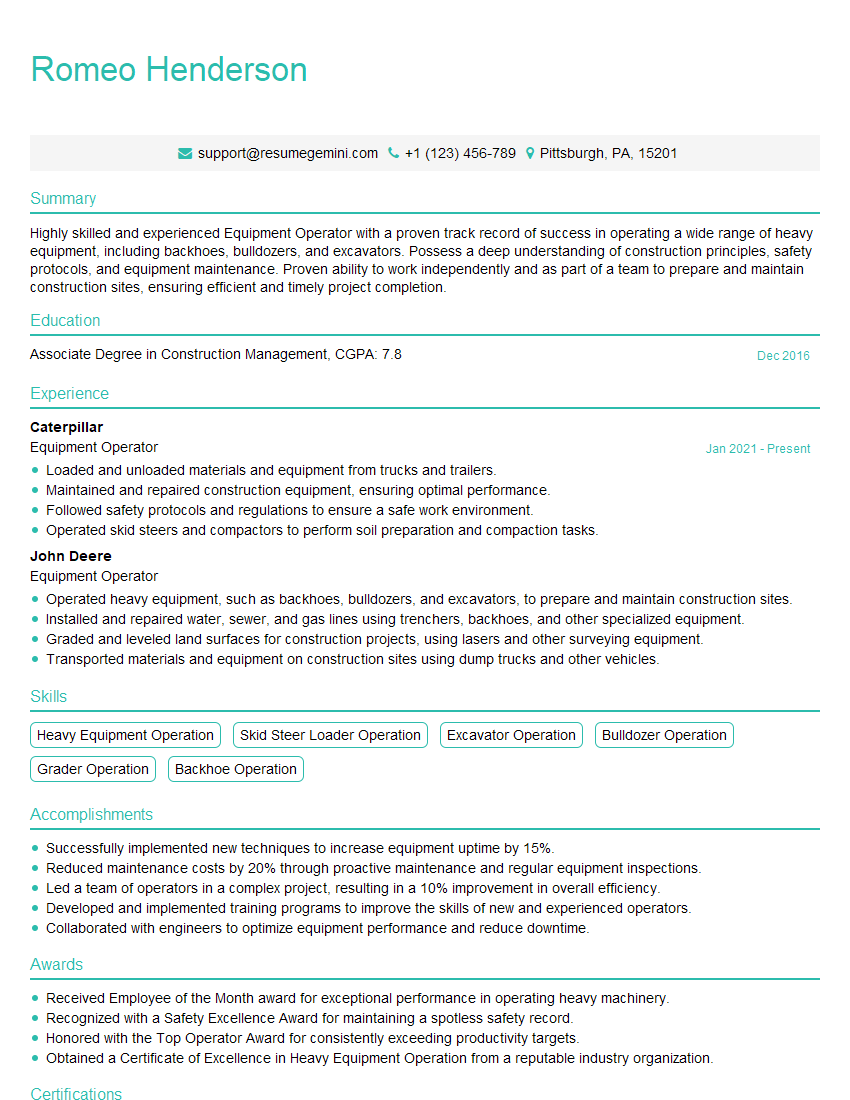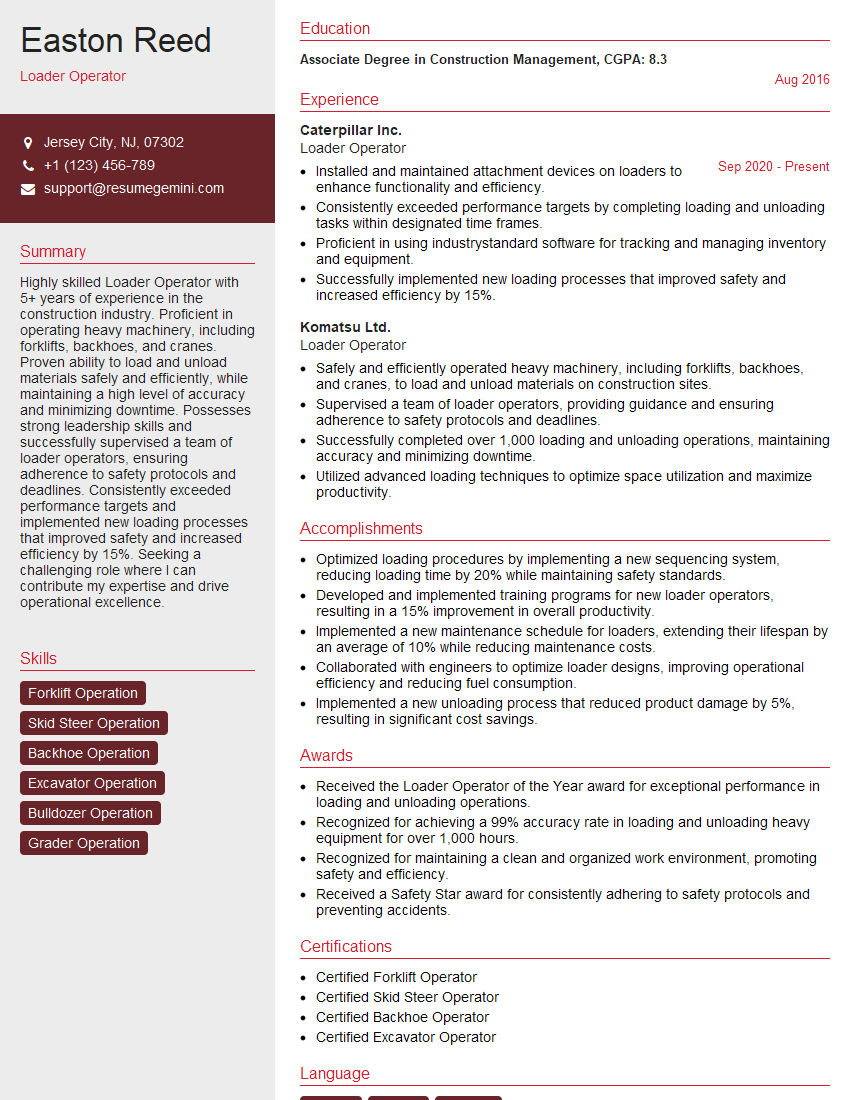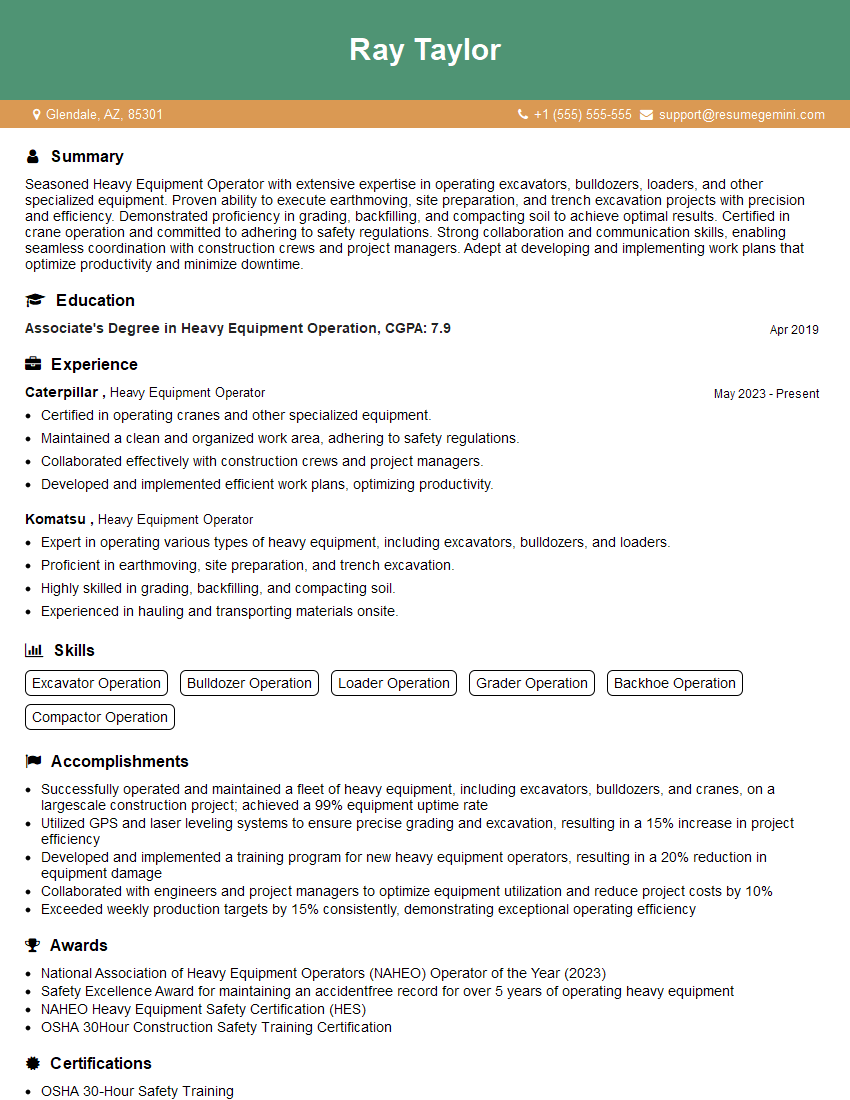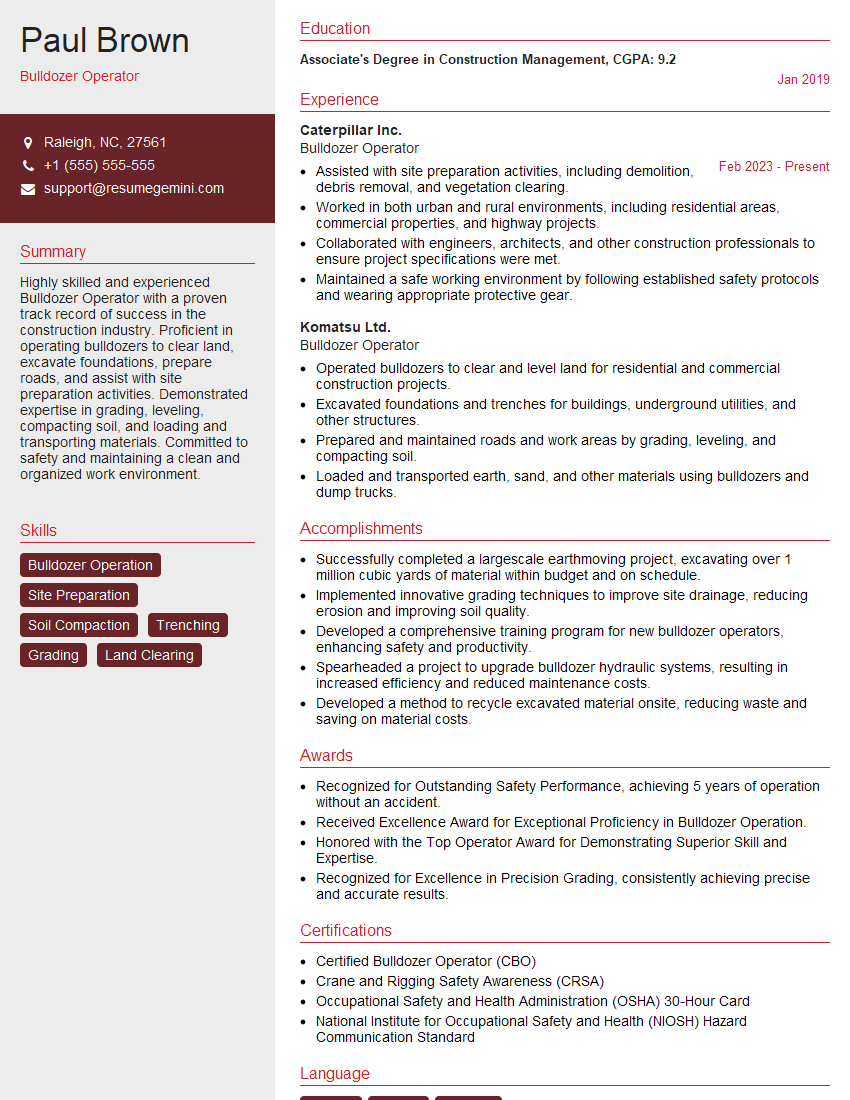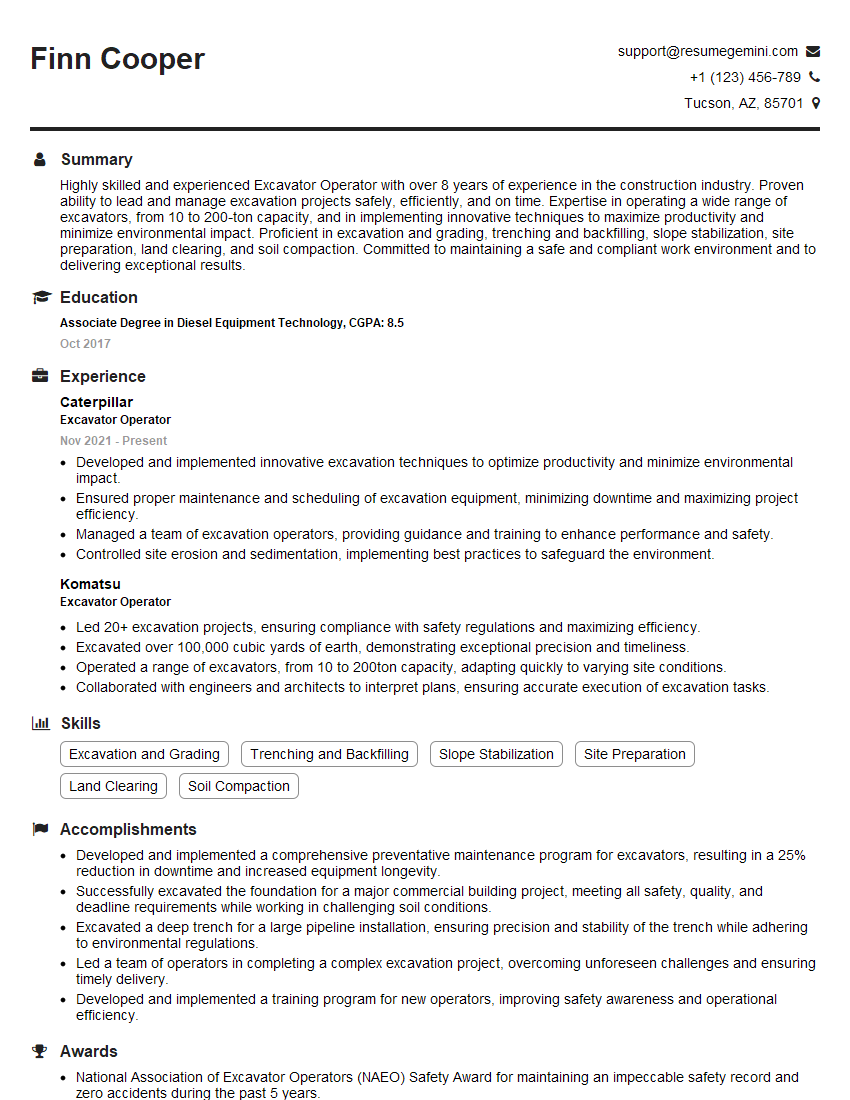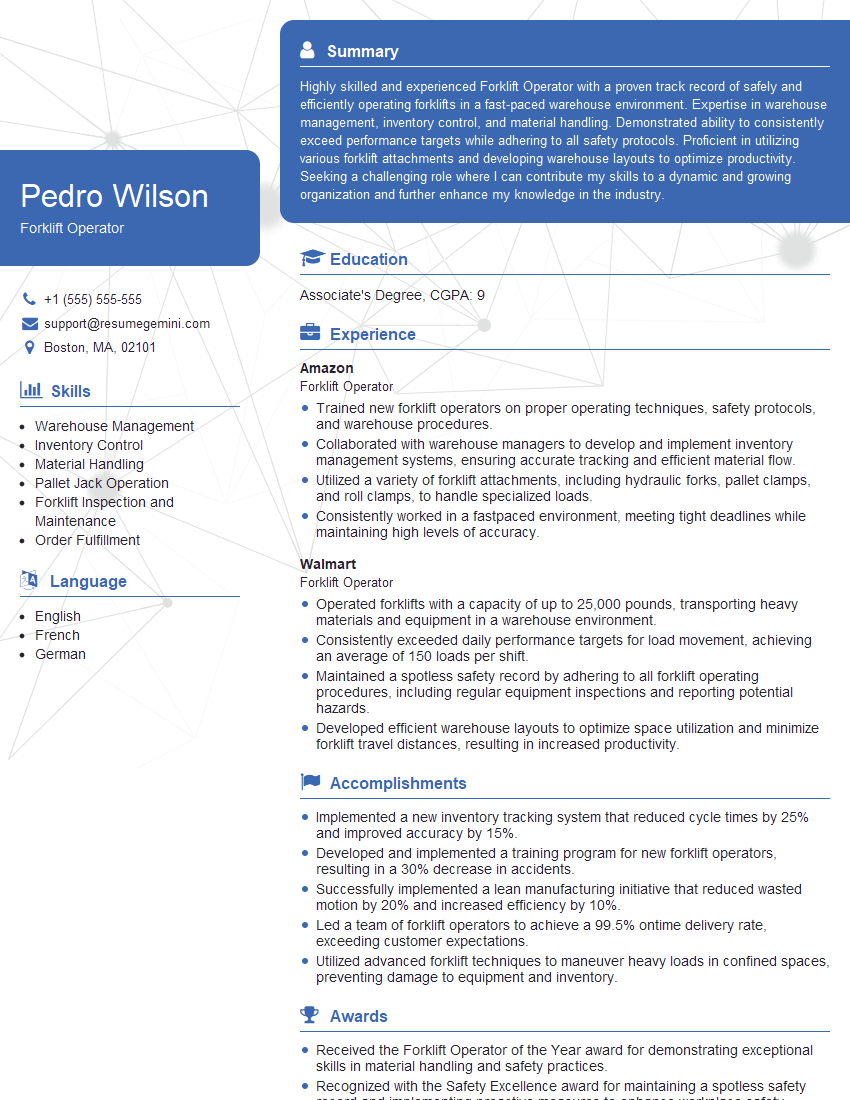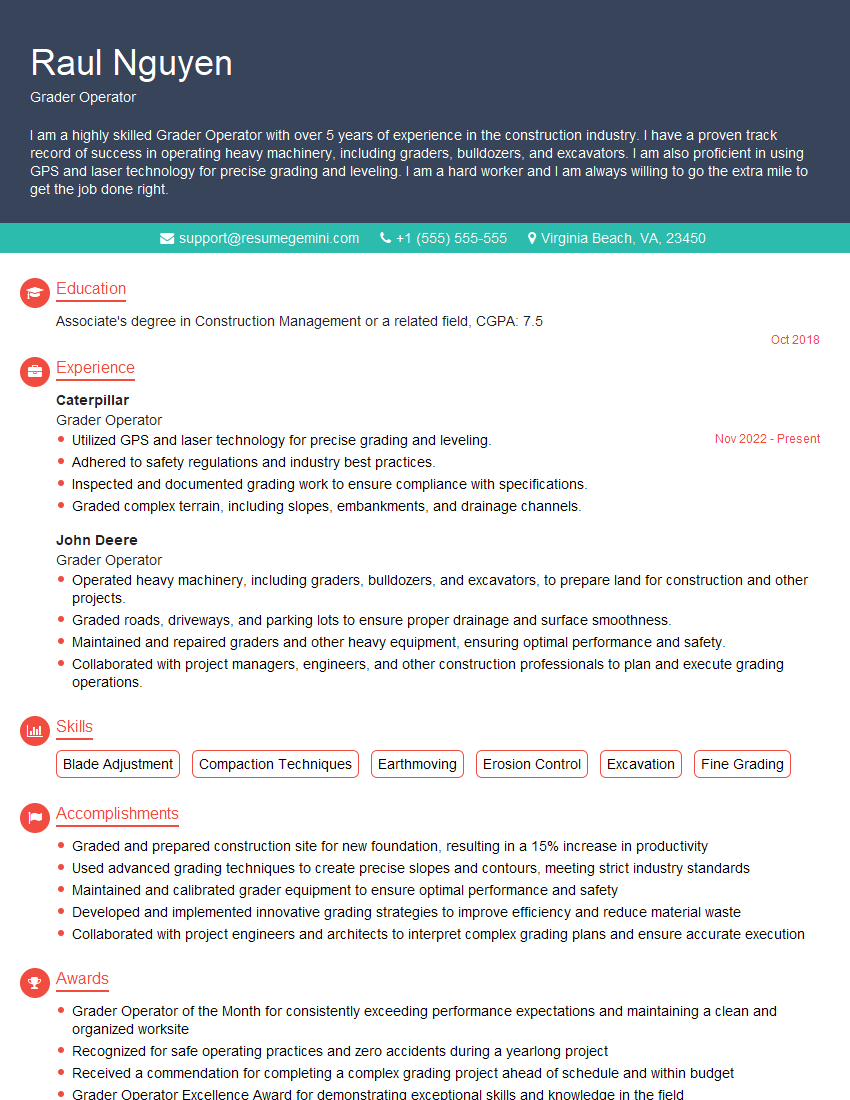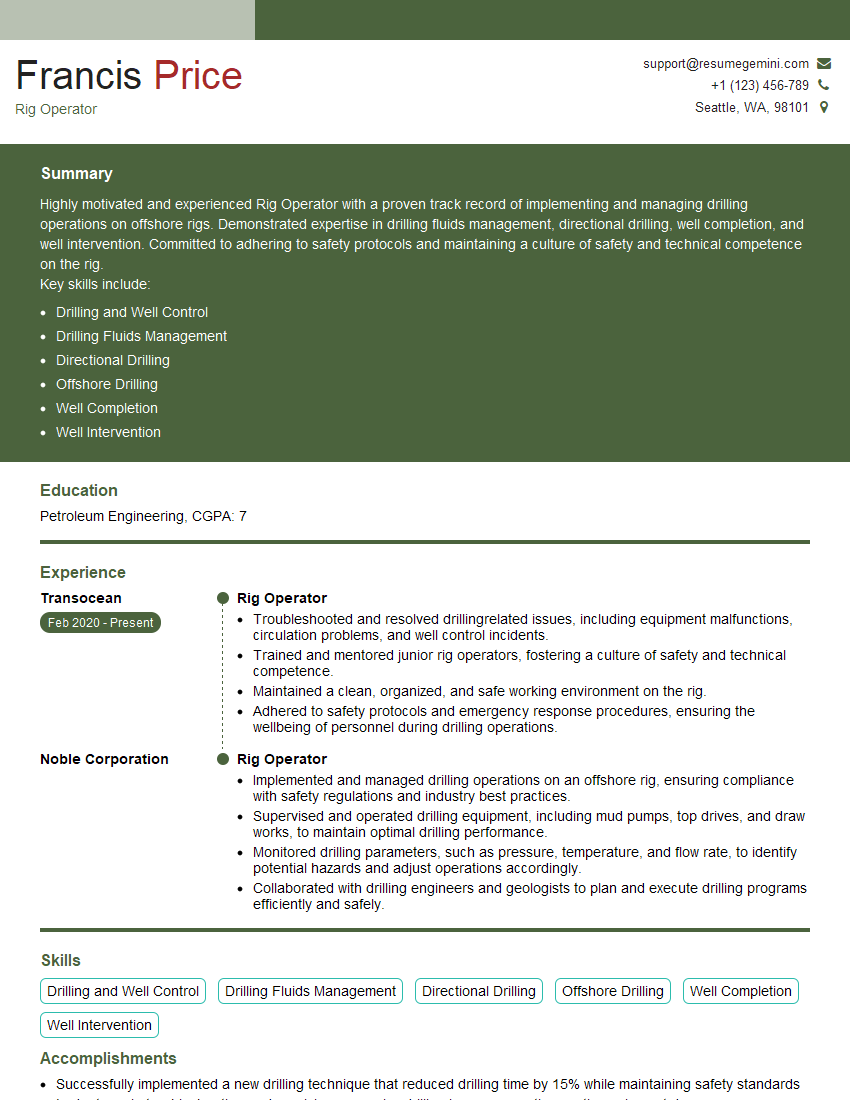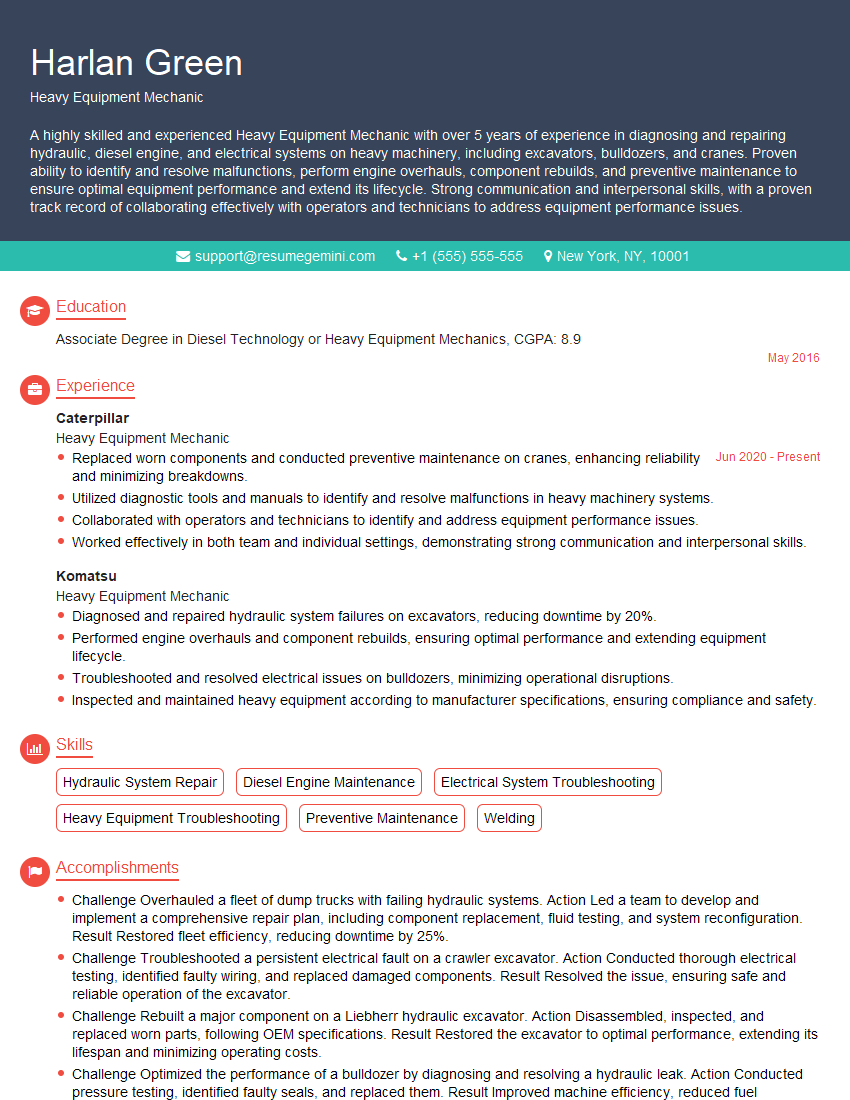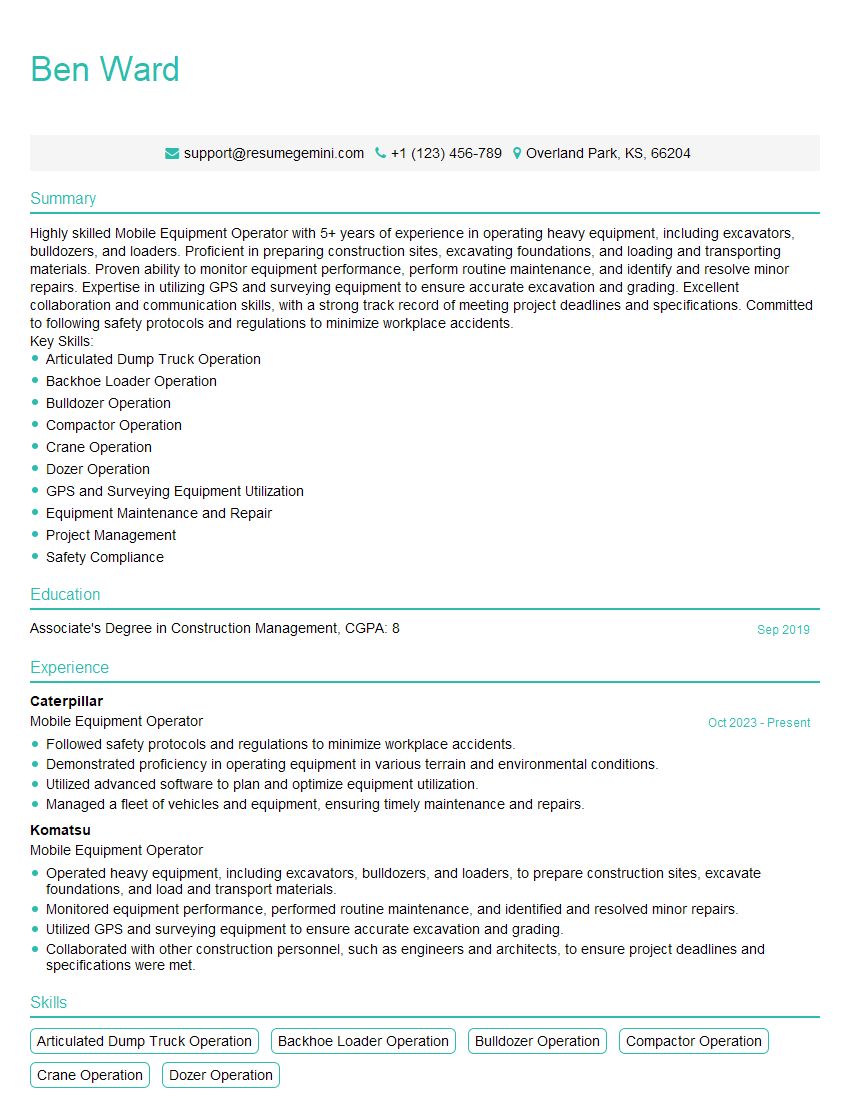The right preparation can turn an interview into an opportunity to showcase your expertise. This guide to Equipment Handling and Operation interview questions is your ultimate resource, providing key insights and tips to help you ace your responses and stand out as a top candidate.
Questions Asked in Equipment Handling and Operation Interview
Q 1. Describe your experience operating a forklift.
My forklift operating experience spans over eight years, encompassing various warehouse and construction environments. I’m proficient in operating both sit-down and stand-up forklifts, and I’ve handled diverse loads, from pallets of goods to heavy machinery components. I’ve consistently demonstrated safe and efficient operation, adhering strictly to all safety regulations. For instance, in a previous role, I successfully managed the loading and unloading of over 500 pallets daily within a tight timeframe without a single incident. This involved navigating narrow aisles, coordinating with other equipment operators, and ensuring the stability of loads at all times. My skills extend to using various attachments, such as clamps and forks, based on load requirements.
Q 2. What safety procedures do you follow when operating heavy machinery?
Safety is paramount when operating heavy machinery. My procedures always begin with a thorough pre-operational check (detailed in the next answer). Beyond that, I consistently follow these crucial safety measures:
- Personal Protective Equipment (PPE): Always wearing the appropriate PPE, including safety glasses, hearing protection, steel-toed boots, and a high-visibility vest.
- Awareness of Surroundings: Maintaining constant awareness of my surroundings, including pedestrians, other equipment, and obstacles. I use mirrors, horns, and hand signals effectively to communicate and avoid collisions.
- Safe Load Handling: Ensuring loads are properly secured and within the forklift’s weight capacity. I always check the load center of gravity to prevent tipping.
- Speed Control: Operating the machinery at a safe speed, adjusting speed according to conditions. I never exceed safe operating speeds.
- Following Procedures: Strict adherence to all company safety procedures and guidelines. This includes attending regular safety training sessions and refresher courses.
- Reporting Issues: Immediately reporting any equipment malfunctions or unsafe conditions to my supervisor.
For example, during a particularly busy shift, I noticed a loose floorboard. I immediately stopped work, reported the hazard, and ensured the area was cordoned off until repairs were made. Preventing accidents is my top priority.
Q 3. Explain the pre-operational checks you perform before using equipment.
Before operating any equipment, I conduct a meticulous pre-operational check, a checklist I’ve developed over years of experience. This checklist includes:
- Visual Inspection: Checking for any visible damage, leaks, or loose components on the machinery itself.
- Fluid Levels: Checking and topping off engine oil, hydraulic fluid, coolant, and fuel levels as needed.
- Tire Pressure: Ensuring tires are properly inflated.
- Lights and Signals: Verifying that all lights and signals are functioning correctly.
- Brakes and Steering: Testing the brakes and steering mechanisms to ensure smooth and responsive operation.
- Safety Devices: Checking that all safety devices, such as seatbelts, horns, and emergency stops, are in working order.
- Load Capacity: Confirming that the equipment’s rated load capacity is sufficient for the intended task.
Imagine a situation where a hydraulic leak is unnoticed. This could lead to a catastrophic failure during operation. My meticulous checks help prevent such scenarios. I document every check, ensuring a transparent record of the equipment’s condition before and after use.
Q 4. How do you handle unexpected equipment malfunctions?
Unexpected equipment malfunctions require a calm and methodical response. My approach follows these steps:
- Immediate Shutdown: Safely shut down the equipment, following the manufacturer’s instructions.
- Assessment: Assess the nature and severity of the malfunction. Is it a minor issue or something more significant?
- Safety Measures: Take immediate safety precautions to prevent any further hazards.
- Reporting: Report the malfunction to my supervisor or maintenance team immediately, providing detailed information about the problem.
- Documentation: Document the malfunction, including the date, time, and details of the incident.
- Awaiting Repair: Awaiting instruction from the supervisor before attempting any repairs or restarting the equipment.
For example, if the engine stalls, I’d ensure the equipment is in a safe position, turn off the ignition, engage the parking brake, and then contact my supervisor. I wouldn’t attempt any troubleshooting or repairs on my own unless I’m explicitly qualified to do so.
Q 5. Describe your experience with preventative maintenance on equipment.
Preventative maintenance is critical for equipment longevity and safety. My experience includes regular inspections, lubrication, and minor repairs. I’m familiar with manufacturer’s recommended maintenance schedules and follow them meticulously. This often involves cleaning, inspecting components for wear, tightening bolts, and replacing worn parts before they cause larger problems. In a previous role, I implemented a daily equipment check system that helped significantly reduce downtime due to unexpected equipment failures. This system involved creating a detailed checklist for daily maintenance tasks, scheduling routine servicing, and keeping detailed records of all maintenance activities. The result was a noticeable decrease in major repairs and increased operational efficiency.
Q 6. What are the different types of excavators and their applications?
Excavators come in various types, each suited for specific applications:
- Hydraulic Excavators: The most common type, using hydraulic cylinders for movement. They’re versatile, used in digging trenches, demolition, and material handling. Subtypes include mini-excavators (for confined spaces) and long-reach excavators (for wide areas).
- Cable Excavators: Using cables and drums for movement. They’re robust and powerful, often used in large-scale projects like mining or quarrying.
- Dragline Excavators: Using a long boom and bucket to dig and swing material. Ideal for deep excavations and dredging.
- Wheel Excavators: Mounted on wheels for easy mobility. They’re efficient for moving from one site to another and often used in road construction or urban projects.
Choosing the right excavator depends on the project’s scope. A mini-excavator is perfect for a small residential project, whereas a large hydraulic excavator is necessary for a large-scale infrastructure project.
Q 7. How do you ensure the safe loading and unloading of materials?
Safe loading and unloading require careful planning and execution. My approach incorporates:
- Pre-Inspection: Inspecting the area for hazards, such as uneven ground or obstructions.
- Load Securing: Properly securing the load using appropriate straps, chains, or other securing methods, ensuring the load is stable and won’t shift during transit. I ensure the load is distributed evenly to prevent overloading.
- Equipment Capacity: Verifying that the equipment used for loading and unloading has the capacity to handle the weight and size of the load.
- Communication: Effective communication with other workers involved in the loading and unloading process. This often involves hand signals or verbal communication.
- Safe Lifting Techniques: Employing proper lifting techniques to prevent accidents and injuries.
- Post-Inspection: Checking the load and securing points after loading and unloading to ensure everything remains stable.
For instance, when unloading heavy equipment, I always ensure that the receiving area is prepared, the equipment is appropriately positioned, and that there are adequate personnel to assist in guiding the load. Careful planning and communication prevent accidents.
Q 8. What are the load capacity limits for a forklift you’re familiar with?
Load capacity limits for forklifts vary significantly depending on the model, make, and mast configuration. For example, I’m very familiar with the Hyster H80FT, a common model in our warehouse. This particular forklift has a rated capacity of 8,000 pounds at a load center of 24 inches. This means it can safely lift 8,000 pounds provided the weight is evenly distributed and the center of gravity is within 24 inches of the mast. Exceeding this limit, or improperly distributing the weight, can lead to serious accidents, including tipping and structural failure. It’s crucial to always consult the manufacturer’s data plate located on the forklift itself for the precise load capacity and operating instructions specific to that machine. Never guess; always check.
Another example, a smaller forklift like a Toyota 8-Series might only have a capacity of 5,000 pounds, highlighting how important it is to choose the right equipment for the job.
Q 9. Explain your experience with different types of crane operations.
My experience with crane operations encompasses various types, including overhead cranes, tower cranes, and mobile cranes. With overhead cranes, I’ve worked extensively with both bridge cranes and gantry cranes in manufacturing and warehousing environments. I’m proficient in safely rigging loads using various slings and attachments, ensuring proper load distribution and stability. My experience includes operating tower cranes on construction sites, which requires a thorough understanding of wind speeds, load charts, and working at heights. I’m also familiar with the intricacies of operating mobile cranes, including performing pre-operational inspections, understanding the limitations imposed by ground conditions, and adhering to strict safety regulations concerning outriggers and counterweights.
Each crane type presents unique challenges and safety considerations. For example, accurately assessing wind conditions is critical when operating a tower crane, while ground stability is paramount when using a mobile crane. I always prioritize detailed pre-operational checks and meticulous adherence to safety protocols to ensure every lift is performed safely and efficiently.
Q 10. How do you maintain awareness of your surroundings while operating equipment?
Maintaining situational awareness is paramount in equipment operation. It’s more than just looking; it’s a proactive and continuous process. Before even starting the equipment, I conduct a thorough visual inspection of the area, identifying potential hazards such as pedestrians, obstacles, uneven terrain, and overhead obstructions. While operating, I constantly scan my surroundings using my mirrors and my peripheral vision, anticipating potential movements or changes. I use audible warnings where appropriate to alert others of my presence and movements.
Think of it like driving a car – you don’t just look ahead; you check your mirrors, blind spots, and constantly scan for potential problems. The difference is that the consequences of an accident with heavy equipment are far more severe.
I’ve even developed the habit of mentally rehearsing the route before commencing operations, especially in complex environments. This mental preparation helps minimize surprises and ensures a smoother, safer operation.
Q 11. Describe your experience working in confined spaces with equipment.
Operating equipment in confined spaces demands extra caution and specialized knowledge. I’ve worked in numerous situations where space was limited, such as loading trucks in tight dock areas or maneuvering equipment in narrow aisles of warehouses. In such scenarios, the emphasis is on precision and slow, deliberate movements. I always ensure that the equipment is properly sized for the space, and that there’s adequate clearance for all maneuvers. Detailed pre-planning and communication with any personnel working alongside me is essential.
One instance involved using a small forklift to maneuver pallets in a very narrow storage area. Due to limited visibility, I had to rely on my spotter’s directions and proceed slowly and cautiously, regularly checking clearance and making micro-adjustments.
Confined space work often requires additional safety measures like increased lighting and possibly the use of a spotter to ensure visibility and avoid collisions. I always follow safety protocols specific to the situation.
Q 12. How do you handle challenging terrain while operating heavy equipment?
Handling challenging terrain requires both experience and the right equipment. The approach differs depending on the type of terrain and equipment. For example, when operating a bulldozer on uneven ground, I adjust my speed and technique to maintain stability and prevent tipping. I might use lower gears for increased traction and carefully navigate slopes and obstacles. With a forklift on uneven ground, I proceed with extreme caution, ensuring the load is secure and that I have a stable base. I may choose to use counterweights or alternative lifting methods if necessary. I also consider factors like soil conditions, water saturation, and potential for rutting.
If the terrain is particularly difficult, I might not attempt the operation unless proper risk assessments are conducted and appropriate safety measures are implemented. Sometimes, the best solution is to not attempt the task with the available equipment.
Q 13. What are the common causes of equipment failure and how do you troubleshoot them?
Common causes of equipment failure include inadequate maintenance, operator error, and environmental factors. Inadequate maintenance leads to component wear and tear, often resulting in hydraulic leaks, engine problems, or electrical faults. Operator error can include overloading the equipment, improper operation, or ignoring warning signs. Environmental factors, such as extreme temperatures or harsh weather, can significantly impact equipment lifespan and reliability.
Troubleshooting involves systematic analysis. For example, if the equipment won’t start, I’d first check the battery, then the fuel system, and then move on to the ignition system. I use diagnostic tools and my knowledge of the specific equipment’s mechanics to identify the problem. If the problem is beyond my expertise, I’ll call in a qualified technician. Preventative maintenance plays a critical role, with regular checks and lubrication greatly reducing the risk of failures. I maintain detailed records of all inspections, repairs, and maintenance performed on the equipment. This helps identify patterns and prevent future issues.
Q 14. Explain your understanding of OSHA regulations related to equipment operation.
My understanding of OSHA regulations regarding equipment operation is extensive. I am well-versed in the regulations pertaining to pre-operational inspections, operator training and certification, personal protective equipment (PPE), safe operating procedures, and emergency response protocols. This includes detailed knowledge of load capacity limits, safe lifting techniques, the proper use of safety devices, and procedures for working near energized equipment. OSHA emphasizes the importance of regular equipment inspections and maintenance. I ensure that all equipment I operate meets the relevant standards and that I adhere strictly to all safety guidelines to mitigate risks. I’m familiar with the reporting procedures for accidents and near misses, understanding the importance of documenting incidents thoroughly and taking corrective actions.
Ignoring OSHA regulations can lead to severe consequences, including accidents, fines, and potential legal liability. Safety is not just a regulation; it’s a top priority.
Q 15. How do you communicate effectively with your team during equipment operation?
Effective communication during equipment operation is paramount for safety and efficiency. My approach involves a multi-faceted strategy focusing on clarity, pre-operation briefings, and ongoing communication throughout the task.
- Pre-operation briefings: Before starting any operation, I conduct a thorough briefing with my team, outlining the task, safety procedures, potential hazards, and individual roles and responsibilities. This ensures everyone is on the same page and understands the plan. For instance, if we’re working near power lines, I’ll clearly explain the safe distances and emergency procedures.
- Clear and concise instructions: During the operation, I use clear, concise language, avoiding jargon. Hand signals are crucial, especially in noisy environments. I make sure everyone understands the signals before we begin.
- Open communication channels: I encourage open communication and feedback. Team members are empowered to voice concerns or suggest improvements at any time. A simple ‘thumbs up’ or a quick radio check-in can prevent accidents.
- Post-operation debrief: After each operation, we conduct a debrief to discuss what went well, what could be improved, and any near misses. This fosters continuous learning and improvement.
Career Expert Tips:
- Ace those interviews! Prepare effectively by reviewing the Top 50 Most Common Interview Questions on ResumeGemini.
- Navigate your job search with confidence! Explore a wide range of Career Tips on ResumeGemini. Learn about common challenges and recommendations to overcome them.
- Craft the perfect resume! Master the Art of Resume Writing with ResumeGemini’s guide. Showcase your unique qualifications and achievements effectively.
- Don’t miss out on holiday savings! Build your dream resume with ResumeGemini’s ATS optimized templates.
Q 16. Describe your experience with different types of attachments used with loaders.
My experience encompasses a wide range of loader attachments, each designed for specific tasks. I’m proficient with:
- Buckets: Various sizes and types, from general-purpose buckets for moving bulk materials like dirt and gravel, to specialized buckets for handling specific materials like asphalt or snow.
- Forks: Essential for lifting and transporting pallets, materials, and other objects. I’ve worked with various fork types and capacities, ensuring safe and efficient handling.
- Grapples: Used for handling logs, scrap metal, and other irregularly shaped materials. Safety is crucial here, ensuring proper clamping and secure transportation.
- Augers: Used for drilling holes for planting or other purposes. Proper soil conditions and auger selection are crucial for efficient operation and preventing damage to the equipment.
- Snow blowers: Effective for snow removal in winter conditions. Understanding snow density and proper techniques is essential for safe and efficient snow removal.
Understanding the limitations of each attachment and their proper usage is key to preventing accidents and ensuring efficient operation. For example, using a grapple to lift heavy concrete slabs could lead to instability and damage.
Q 17. How do you ensure the stability of loads during transportation?
Load stability is critical for safe transportation. My strategies focus on:
- Proper loading techniques: Distributing the weight evenly across the vehicle and ensuring the center of gravity is low. Avoid overloading the equipment.
- Securing the load: Using appropriate straps, chains, or other tie-downs to prevent shifting or falling during transportation. The type of restraint depends on the load and transportation conditions.
- Regular inspections: Checking the load and restraints frequently during transportation to identify any potential issues.
- Appropriate speed and route planning: Adjusting speed and route to account for road conditions and load stability. Avoid sudden braking or sharp turns.
- Understanding load limits: Never exceeding the equipment’s weight or capacity limits.
For instance, when transporting heavy beams, I use multiple secure tie-downs and ensure they’re properly rated for the load weight. Regular inspections and maintaining safe speeds prevent accidents.
Q 18. What are your strategies for working efficiently and safely under pressure?
Working efficiently and safely under pressure requires a systematic approach:
- Prioritization: Identify the most critical tasks and address them first. This helps maintain focus and prevent feeling overwhelmed.
- Time management: Break down large tasks into smaller, manageable steps. This helps track progress and maintain a sense of control.
- Delegation: Where appropriate, delegate tasks to competent team members, maximizing efficiency and preventing burnout.
- Focus and mindfulness: Maintaining focus on the task at hand and practicing mindfulness to manage stress and prevent errors.
- Regular breaks: Taking short breaks to rest and refocus can improve performance and reduce fatigue.
For example, during a time-sensitive project, I prioritize the most urgent tasks, delegate less critical tasks where possible, and take short breaks to avoid making mistakes due to fatigue.
Q 19. How do you prioritize safety during emergency situations involving equipment?
Safety is always the top priority during emergencies. My approach involves:
- Immediate assessment: Quickly assess the situation and identify the immediate hazards.
- Emergency shutdown procedures: Immediately shut down the equipment using proper procedures.
- Evacuation and communication: Evacuate the area and communicate the emergency to appropriate personnel.
- First aid and emergency response: Provide first aid as needed and contact emergency services if necessary.
- Securing the scene: Secure the scene to prevent further accidents and preserve evidence.
For example, if a fuel leak occurs, I’d immediately shut down the equipment, evacuate the area, notify the supervisor, and contact emergency services. Preventing further accidents is paramount.
Q 20. Describe your experience documenting equipment use and maintenance logs.
Accurate documentation is crucial for equipment maintenance and regulatory compliance. My experience includes:
- Daily equipment inspections: I meticulously document daily inspections, noting any issues or required maintenance.
- Maintenance logs: I keep detailed maintenance logs, recording all repairs, replacements, and service intervals. This ensures equipment longevity and prevents unexpected failures.
- Fuel and usage records: I accurately track fuel consumption and equipment usage hours, providing vital data for cost analysis and operational planning.
- Incident reports: In case of incidents or accidents, I prepare comprehensive incident reports, documenting the circumstances, injuries, and corrective actions.
- Digital record keeping: I’m proficient in using digital platforms for record-keeping, providing efficient data management and accessibility.
I strive for complete and accurate records, adhering to company and industry standards. For example, I always include dates, times, personnel involved, and specific details of any maintenance or repairs.
Q 21. What are the key differences between different types of bulldozers?
Bulldozers vary significantly depending on their application and the type of work they perform. Key differences include:
- Blade type: Different blade types are designed for specific tasks. Straight blades are excellent for moving large volumes of material, while angle blades offer versatility for fine grading and ditching. U-blades are efficient for pushing snow.
- Track type: Crawler tracks provide superior traction in challenging terrain, while some smaller bulldozers may have wheeled configurations for greater mobility on smoother surfaces.
- Engine power: Engine power determines the bulldozer’s capacity to move earth and the size of the projects it can handle. Larger projects require more powerful engines.
- Size and weight: The size and weight of the bulldozer influence its manoeuvrability and ability to operate in different environments. Larger bulldozers are ideal for large-scale projects, while smaller ones can be more easily maneuvered in tight spaces.
- Implementations: Additional attachments such as rippers are used to break up hard ground, significantly expanding the bulldozer’s capability.
Choosing the right bulldozer depends on factors like terrain, materials to be moved, and the project’s scale. A small, wheeled bulldozer is unsuitable for large-scale earthmoving on rugged terrain, while a large crawler bulldozer may be impractical in a restricted urban environment.
Q 22. How do you handle difficult or uncooperative coworkers in a team setting?
Handling difficult coworkers requires a professional and proactive approach. My strategy focuses on open communication and collaboration. First, I attempt to understand the root cause of the uncooperative behavior – is it a misunderstanding, a personality clash, or a workplace issue? Once identified, I try to address the problem directly, but always respectfully. This might involve a private conversation to clarify expectations, or suggesting a collaborative problem-solving approach to a project. If direct communication doesn’t resolve the issue, I involve my supervisor to mediate and find a mutually agreeable solution. I believe in maintaining a professional demeanor even in challenging situations, focusing on the task at hand and the team’s overall success. For instance, on a previous project, a colleague consistently missed deadlines, impacting our progress. Instead of confrontation, I scheduled a meeting to discuss the challenges he faced and collaborated on creating a revised schedule that accommodated his needs while ensuring we met our overall objectives. This collaborative approach fostered a better working relationship and improved project outcomes.
Q 23. Describe your experience using GPS or other technology for equipment guidance.
I have extensive experience utilizing GPS technology and other guidance systems for efficient equipment operation. In my previous role, we used GPS-guided excavators for precise trenching and grading. The GPS system provided real-time location data, allowing for accurate positioning and minimizing errors. This technology significantly improved productivity and reduced material waste. We also used machine control systems integrated with GPS, which allowed for automated grading and contouring, resulting in faster project completion and high-quality results. I’m also familiar with other technologies such as laser-guided systems for precise leveling and total stations for surveying and precise material placement. These technologies require a strong understanding of the equipment’s capabilities and limitations as well as a good grasp of the software interface. For example, understanding how GPS signal interference from tall buildings or heavy foliage can affect accuracy is crucial for safe and effective operation.
Q 24. How do you ensure the accurate measurement and placement of materials?
Accurate measurement and material placement are critical for successful project execution. My approach involves a multi-step process. First, I verify the project plans and specifications to ensure a clear understanding of the required dimensions and tolerances. Next, I use appropriate measuring tools – such as measuring tapes, laser levels, and total stations – depending on the project requirements. For larger projects, I utilize surveying techniques and precision instruments to ensure accuracy. Throughout the process, I double-check all measurements to minimize errors. Finally, I use a variety of tools for material placement; this might include using cranes with precise lifting and positioning capabilities or employing smaller, hand-operated equipment for delicate tasks. For example, during a recent project involving the installation of precise concrete footings, we used a total station for accurate location and a laser level for ensuring proper elevation, significantly reducing errors and rework. Thorough documentation of all measurements and placement is also essential.
Q 25. Explain your understanding of different types of lifting gear.
Lifting gear encompasses a wide range of equipment used to safely lift and move heavy objects. Understanding their types and limitations is paramount for safety. Common types include:
- Chains: Grade 80 chains are common, known for their high tensile strength and are used with appropriate chain binders and shackles.
- Wire ropes: Used in cranes, hoists, and other lifting mechanisms; their strength and durability depend on their construction and diameter.
- Slings: Made from various materials (e.g., polyester, nylon, wire rope), they come in different configurations (e.g., choker, basket, endless) suited to different load types and shapes.
- Shackles: Connecting links that attach the sling to the load or to the crane hook.
- Hooks: Used to connect to slings or directly to loads; careful inspection for damage is crucial.
- Eye bolts: Bolts with a loop at the end for attaching lifting gear.
It’s crucial to select the right type and size of lifting gear for the load, considering the weight, dimensions, and center of gravity. Improper selection can lead to serious accidents. Regular inspection and maintenance of all lifting gear are also essential to ensure safety and prolong equipment life.
Q 26. How do you deal with inclement weather conditions when operating equipment?
Operating equipment in inclement weather requires extra precautions to ensure safety and prevent damage. My approach involves several steps. First, I check weather forecasts before commencing work and adjust the schedule if necessary. During operation, I maintain extra vigilance and slow down operations significantly in conditions such as heavy rain, snow, or strong winds. If visibility is significantly reduced, I may halt operations completely. I always ensure that the equipment is in good working order, with particular attention to tires, brakes, and visibility aids such as lights and wipers. For example, in snowy conditions, I’ll use chains on equipment tires to increase traction and reduce the risk of skidding. If working at heights, I would also carefully consider wind speed and potentially suspend work if the wind is too strong. Safety is paramount in such conditions, and I would always prioritize it over productivity.
Q 27. What is your understanding of load charts and their importance?
Load charts are critical documents that specify the safe working limits of lifting equipment and gear. They indicate the maximum load capacity for different configurations and conditions (e.g., different angles of sling attachment). Understanding and adhering to load charts is essential for preventing accidents and ensuring the safe operation of equipment. Ignoring load charts can lead to equipment failure, damage to materials, or serious injuries. Before any lifting operation, I carefully review the load chart for the specific equipment and gear being used to ensure the load is within the safe operating limits. I always take into account the weight, type and shape of the load, the position of the load relative to the lifting point and any other factors which might impact the safe lifting capacity. The chart provides crucial safety information and is not a suggestion but a mandatory requirement for safe lifting practices. For example, a load chart might specify that a particular crane can lift a 10-ton load only when the boom is at a specific angle. Exceeding these limits is unsafe and against safety regulations.
Q 28. Describe your experience with specialized equipment operation (e.g., aerial lifts).
I have significant experience operating specialized equipment, particularly aerial lifts. This includes boom lifts, scissor lifts, and articulated lifts. Before operating any aerial lift, I always undergo thorough training and receive the necessary certification to ensure competence. I carefully inspect the equipment before each use, checking for any signs of damage or malfunction, paying close attention to hydraulics, safety mechanisms, and emergency shut-offs. During operation, I adhere strictly to the manufacturer’s guidelines and safety procedures, including proper load limits, stable ground conditions, and secure positioning of the lift. I am also aware of the potential hazards associated with aerial lift operation, including falls, electrical hazards, and crushing injuries. When working at height, I always wear appropriate safety equipment like a harness and use fall protection systems as required. During a construction project, I was responsible for operating a boom lift to install HVAC units on the roof of a multi-story building. Careful adherence to safety protocols ensured that the project was completed without any incidents.
Key Topics to Learn for Equipment Handling and Operation Interview
- Safety Procedures and Regulations: Understanding and applying relevant safety protocols, including pre-operational checks, lockout/tagout procedures, and emergency response plans. Practical application includes demonstrating knowledge of specific regulations for your industry and equipment.
- Equipment Operation & Maintenance: Mastering the operation of various types of equipment (forklifts, cranes, excavators, etc.), including start-up, shutdown, and routine maintenance procedures. This includes troubleshooting common malfunctions and knowing when to seek professional assistance.
- Load Handling & Stability: Calculating load weights, understanding center of gravity, and ensuring safe and stable load placement and transportation. Practical application involves explaining how to assess risk and prevent tipping or accidents.
- Technical Specifications & Troubleshooting: Understanding the technical specifications of different equipment, including engine types, hydraulic systems, and electrical components. This also includes developing effective troubleshooting strategies to address operational issues.
- Communication & Teamwork: Effective communication with colleagues, supervisors, and other personnel on the job site, highlighting teamwork and coordination skills necessary for safe and efficient operation.
- Preventive Maintenance & Inspections: Understanding the importance of regular preventative maintenance and inspections to identify potential problems before they occur. This includes documenting maintenance activities and reporting issues promptly.
Next Steps
Mastering Equipment Handling and Operation opens doors to rewarding careers with excellent growth potential in diverse industries. A strong understanding of these skills demonstrates your commitment to safety and efficiency, making you a highly valuable asset to any team. To increase your chances of landing your dream job, invest time in crafting a professional, ATS-friendly resume that highlights your qualifications effectively. ResumeGemini is a trusted resource that can help you build a compelling resume tailored to your skills and experience. Examples of resumes tailored to Equipment Handling and Operation are available, showcasing how to present your expertise in the best possible light. Take the next step toward your career goals today!
Explore more articles
Users Rating of Our Blogs
Share Your Experience
We value your feedback! Please rate our content and share your thoughts (optional).
What Readers Say About Our Blog
good
